Renovating an aging swimming pool can restore its functionality and aesthetic appeal without the need for a costly full reconstruction, breathing new life into your backyard. For pools with cracked plaster, deteriorating tile, or other surface issues, a thick reinforced PVC membrane (e.g., Cefil 60 mil pool liner) offers a watertight, attractive, affordable, and durable solution. This article explains how PVC membranes can revitalize old pools, outlines the renovation process, and highlights significant cost savings compared to full reconstruction ($10,000–$20,000 vs. $50,000+), making it an ideal choice for homeowners seeking an affordable upgrade.
Why Choose PVC Membranes for Pool Renovation?
Aging pools, especially those with plaster (5–10-year lifespan) or tile (10–15 years), often develop cracks, stains, or leaks due to wear, freeze-thaw cycles, or structural shifts. These issues can lead to water loss, algae growth, or expensive repairs. Notably, PVC membranes are also suitable for repairing cracked fiberglass pools.
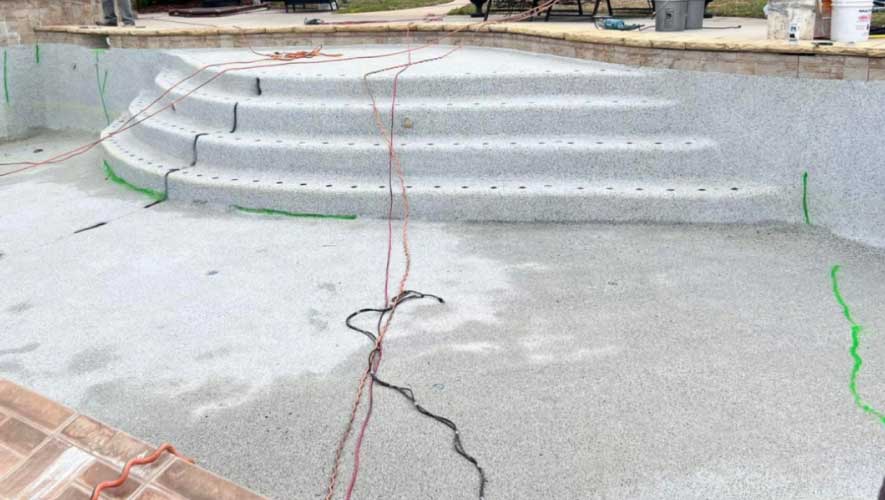
Thick PVC membranes, reinforced with a polyester mesh core, provide a flexible, durable, non-porous lining. They prevent water leakage through cracks in the pool shell, resist algae and UV, and can last 20–30 years. With a wide range of colors and textures, they allow for customized aesthetics (e.g., mimicking tile or natural stone).
Benefits of PVC Membranes
Watertight Seal: Covers existing cracks and leaks in old plaster or tile, preventing water loss without invasive structural repairs.
Low Maintenance: The non-porous surface resists algae and stains, reducing chemical use by 15–20% and saving thousands compared to plaster.
Durability: Withstands freeze-thaw cycles and UV exposure, outlasting plaster and rivaling tile at a lower cost.
Cost-Effective: The cost of a PVC membrane for a mid-sized pool, including installation, is $10,000–$20,000, significantly less than traditional pool repairs ($50,000–$100,000).
Aesthetic Versatility: Available in various colors and patterns, allowing personalized finishes that enhance visual appeal without high costs.
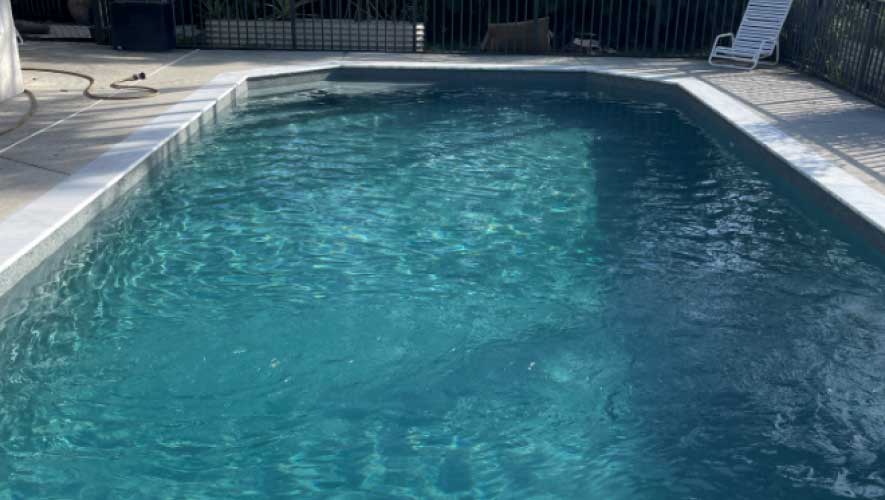
Renovation Steps Using a Thick Reinforced PVC Membrane
Renovating a pool with a PVC membrane is a streamlined process that typically takes 1–2 weeks, compared to 8–12 weeks for a traditional full reconstruction. Here’s a step-by-step guide:
Assess and Prepare the Pool
- Inspect the Pool: Evaluate the existing structure for major cracks, leaks, or plumbing issues. Hire a specialist to assess structural integrity ($200–$500).
- Drain and Clean: Fully drain the pool. Remove debris and clean the surface (e.g., with a pressure washer) to eliminate loose plaster, algae, or tile grout residue.
- Repair Structural Issues: Patch minor cracks in the concrete or gunite shell. Major structural repairs may increase costs by $1,000–$3,000.
Time: 2–4 days.
Smooth and Prep the Surface
Sand and Level: Smooth rough plaster or tile edges to create a flat base for the membrane, ensuring tight adhesion. Professional grinding may be required ($500–$1,000).
Check and Replace Plumbing: For pools with tile or plaster, replace skimmers, jets, and drains with models compatible with PVC membranes ($100–$500).
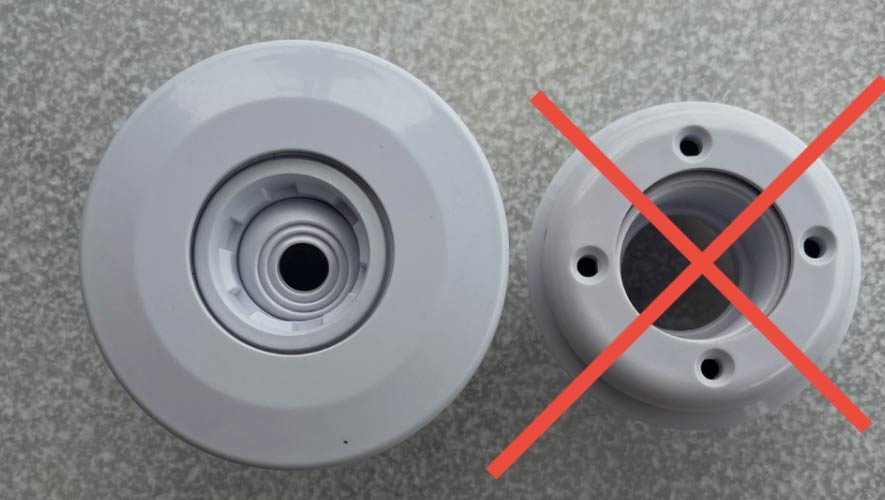
Install Underlayment: Lay a geotextile felt underlayment on the pool surface ($1,000–$2,000). This not only mimics the feel of a soft ocean floor for comfort but also helps retain water warmth.
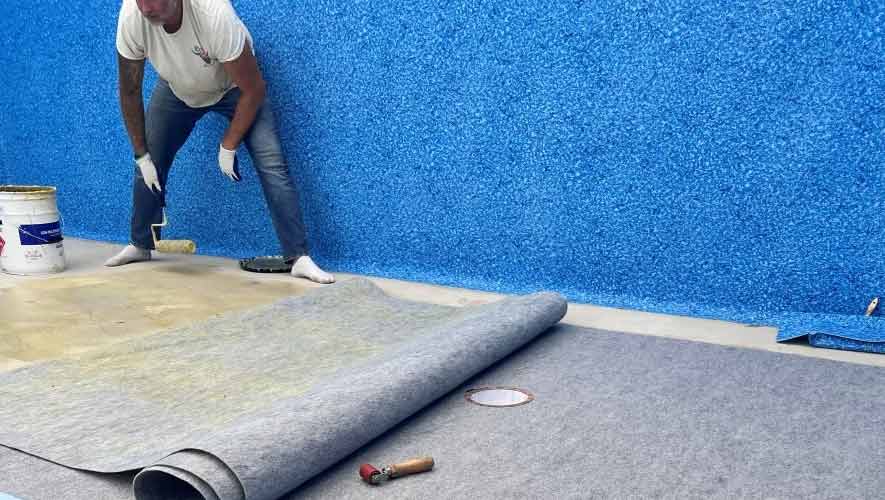
Time: 2–3 days (depending on pool size, shape, and condition).
Install the PVC Membrane
- Measure and Cut: PVC membranes come in rolls, ensuring easy transport and handling. Strips are cut on-site for precision.
- Welding Strips Together: Professionals weld membrane strips with a double seam using hot air and attach them to a laminated profile around the pool’s perimeter. Liquid PVC is applied to welds, creating a strong, watertight seal that prevents leaks, even on cracked surfaces.
- Fastening to Skimmers, Jets, Drains: Secure the membrane to skimmers, jets, and drains with watertight gaskets ($100–$300), tightened with stainless steel screws.
- Cost: $6,000–$10,000 for materials for a 15×30-foot pool.
Time: 1–5 days (depending on pool size and shape).
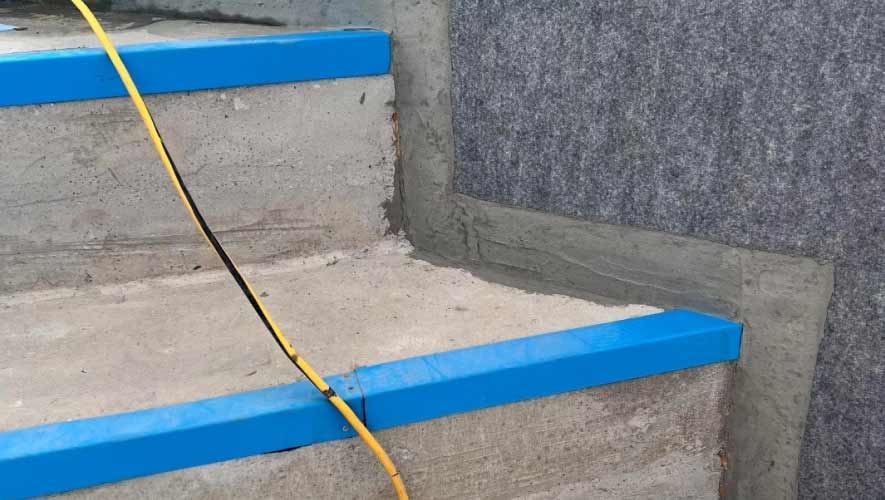
Finish and Test
- Install Coping Stones and Decking: Update or reinstall coping stones and decking if needed ($2,000–$5,000), though existing materials can often be reused.
- Fill and Balance: Fill the pool with water and adjust pH (7.2–7.6), alkalinity (80–120 ppm), and calcium hardness (200–400 ppm). Add minimal algaecide due to PVC’s algae resistance ($50–$100).
- Test for Leaks: Monitor water levels for 24 hours.
Time: 2–3 days.
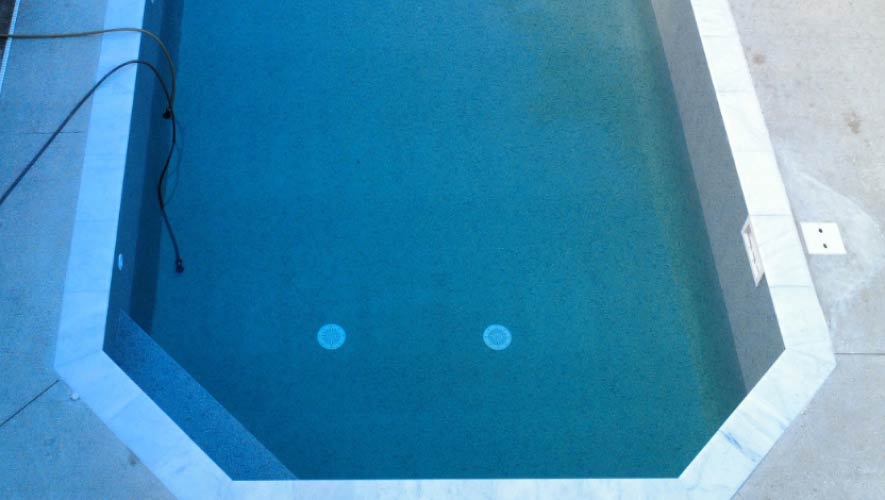
Total Timeline and Cost
Timeline: 1–2 weeks (depending on pool condition, size, and shape) compared to 8–12 weeks for traditional reconstruction.
Cost: $12,000–$30,000 for a mid-sized pool (including inspection, repairs, membrane installation, and coping stones) vs. $80,000–$200,000 for a full pool rebuild.
Cost Savings Compared to Traditional Reconstruction
A full pool rebuild involves demolishing the old structure, re-excavating, and constructing a new shell, costing $50,000–$100,000 for a 15×30-foot pool. This includes:
- Demolition: $10,000–$20,000.
- New Shell (e.g., gunite): $30,000–$40,000.
- Finishing (plaster/tile): $10,000–$30,000.
- Equipment and Decking: $20,000–$50,000.
In contrast, PVC membrane renovation avoids demolition and new shell construction, saving 60–80% ($50,000–$180,000). Maintenance costs are also lower:
- PVC Membrane: $500–$1,000/year (minimal chemicals, rare repairs).
- Plaster (post-rebuild): $1,000–$2,500/year (frequent cleaning, resurfacing every 5–10 years at $5,000–$10,000).
- Tile (post-rebuild): $800–$2,000/year (grout maintenance, replacements at $2,000–$5,000).
Over 10 years, a PVC membrane pool saves $5,000–$15,000 in maintenance compared to plaster or tile, making it a long-term cost-effective solution.
Additional Benefits and Considerations
- Quick Turnaround: Renovation (1–2 weeks) enables faster pool use than traditional rebuilding.
- Eco-Friendly: PVC membranes reduce chemical use and water loss from leaks, lowering environmental impact.
- Customization: Choose colors/textures mimicking high-end tile or stone, improving aesthetics without the $10,000–$20,000 tile cost.
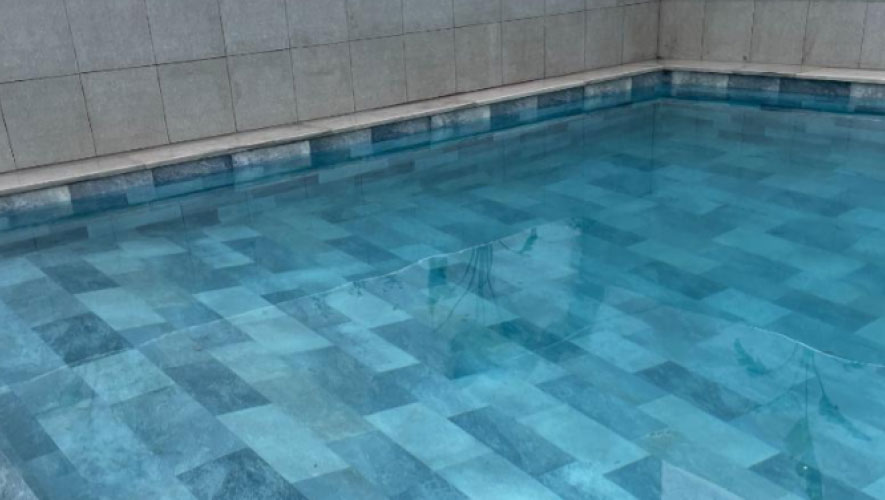
Potential Challenges
Structural Limitations: Severe cracks or shifts in the pool shell may require concrete repairs before membrane installation, adding $1,000–$3,000.
Aesthetic Perception: Some homeowners prefer tile’s premium look, though modern PVC membranes bridge this gap.
Have Questions?
Talk to our specialist! Just fill out the form, and we’ll give you a call!
Conclusion
Renovating an old pool with a thick reinforced PVC membrane is a cost-effective and efficient solution for restoring cracked plaster, tile, or even fiberglass pools. By sealing leaks, reducing maintenance, and offering a 20–30-year lifespan, PVC membranes save $30,000–$80,000 compared to a full rebuild. The process—inspection, surface prep, membrane installation—takes just 1–2 weeks (depending on condition, size, and shape), delivering a durable, low-maintenance pool with personalized design. High-quality PVC membranes are available from SAKKO POOL, ensuring a seamless renovation that transforms your old pool into a vibrant backyard centerpiece.
